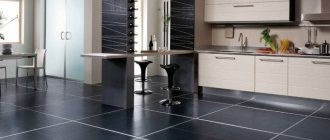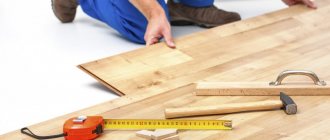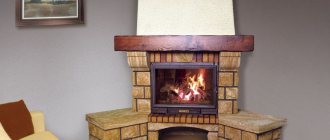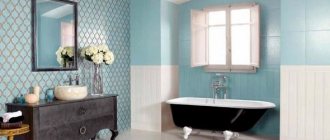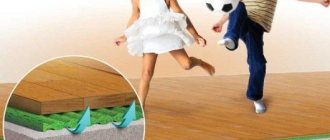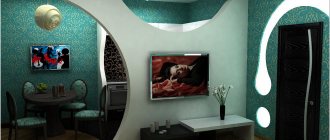Choosing a laminate: what to look for
- Wear resistance. The best material for flooring is 32-34 classes; the latter will last at least 30 years and will not lose its original appearance.
- Moisture resistance. Before you buy a laminate, make sure there are markings with droplets of water, a tap, and words confirming the collection’s resistance to moisture.
- Lock connection. There are two types of lock: Click and Lock. The first one is easier to install, more reliable - it will hold the panels tightly together; the second one is more affordable, but less reliable and can cause difficulties when laying the floor covering; it requires a perfectly leveled base.
- Thickness. The thicker the laminate, the more resistant to fracture and more expensive it is. For the kitchen, the 8-10 mm option is quite suitable.
Kitchen laminate class
If it's time to buy laminate flooring for the kitchen, you need to decide which class of laminate flooring for the kitchen is better than others.
The most preferable would be a moisture-resistant laminate. It contains substances that prevent moisture absorption and protect it from prolonged exposure to water. All butt joints must be treated with wax - a water-repellent substance. But even such a laminate should be protected from water.
For kitchens, the operating class must be at least 32. You should also pay attention to class 33. The manufacturer gives it a 10-15 year warranty.
The advantages of these two classes are that they are very wear-resistant and durable. This laminate will look like new for about 15 - 20 years.
For the kitchen, it is best to choose a relief covering, since the relief hides minor damage well.
If you need a cheaper option, you can purchase a lower class, but be sure to coat the joints between the panels with sealant.
For information on laminate classes and its features, watch the video below.
The most acceptable and relatively inexpensive option for covering a kitchen floor is Tarkett laminate. Over many years of work, this company has been recognized as a leader in the world market and is a pioneer in the field of fashion trends in production in its field. The class of the produced laminate is 32 – 33. When used, it creates the appearance of a single solid board, since the joints between the panels are almost invisible.
Another manufacturer of laminate flooring recommended for kitchens is Balterio. Many consider it the first manufacturer of laminated panels.
Quick Step is the manufacturer of the world's most popular laminate flooring, produced under the Unilin brand. Over many years of work, the quality of products has increased at a tremendous pace, and new modern laminate processing technologies have been introduced. And since 2005, the company became part of the Mohawk Industries Inc. concern, from that moment the products became more in demand all over the world.
Kronoflooring - the company was founded in 2001. Since then, it has established itself quite well in the field of flooring production. At the moment, the company is one of the most popular in the world market. Its products are in demand in 70 countries.
Additional Information:
- Quick Step 33 class The Belgian company Unilin flooring, which produces Quick Step laminate (Quick Step), has existed for more than 20 years. She appeared back in 1989...
- Which class of laminate is better? Everyone who wants to buy a laminate flooring has wondered how to choose it and which class of laminate is better. Let's figure out what kind of laminate is...
- Which laminate is better to choose Before buying a laminate, study the basic properties of the flooring and determine what is most important to you. Let's consider which laminate is better...
- Laminate 32 class Belgium Floor coverings on our market are represented by leading foreign manufacturers. Germany, Austria, Norway, Spain, Poland, Belgium, all of them to a greater or lesser extent...
- Laminate 34 class The person who decided to buy laminate class 34 can only be congratulated. This will be the most profitable purchase at the moment. Laminate…
- German laminate class 32 When considering the types of materials used for flooring, one cannot help but mention laminate. Its production around the world is growing exponentially.…
- Class of laminate for apartments and houses Laminate is a floor covering that appeared on the building materials market relatively recently, but in a short time it began to enjoy unprecedented popularity. This…
Laminate in the kitchen: pros and cons
The advantages of laminate include:
- Resistance: to mechanical damage; abrasion; exposure to direct sunlight; temperature changes.
- Tactile sensations - it is more pleasant to walk on this floor barefoot.
- No dents – marks from furniture legs often remain on linoleum. High-quality laminate is not familiar with this problem.
- Aesthetic appearance - a variety of textures and colors allows your imagination to run wild.
- Environmentally friendly - it does not contain substances that can harm human health.
- Easy to install - a beginner can handle installation.
- Easy to clean - keeping your home clean is incredibly easy.
Disadvantages:
- Risk of bloating. If a hot water pipe breaks, the floor will be replaced. In the case of a flood, there is little that can save the situation, but impregnation will protect you from standard troubles - the risk of ruining the coating will be noticeably reduced. Do not wait for spilled liquid to dry on its own - wipe up puddles in a timely manner.
- Clattering and loud noise when walking. The disadvantage of laminate flooring that pet owners most often complain about is that the clicking sound of their claws echoes throughout all the rooms. A sound-absorbing cork substrate can avoid the problem - it will absorb the steps of household members and reduce impact noise by half.
- Scratches and chips. The risk of this is minimal, but if this happens, then purchase special wax pencils - you will be able to disguise the defect.
Laminate and heated floors: is compatibility possible?
The flooring itself is quite warm, but for some “natural” heat is not enough. If a number of conditions are met, a heated floor system can be installed under the laminate.
Laminate flooring cannot be laid on a floor heating system that runs on electricity. This floor heats up quickly, but unevenly. In such conditions, the planks may fail and cracks will form. Choose water or infrared heated film floors in the store.
When you want to increase the floor temperature, do it gradually, but make sure that the sensor does not show above 28°C. Monitor the humidity in the room - in the kitchen it should not fall below 50%. Otherwise, the laminate will dry out. To avoid this, buy a humidifier.
Variety of design solutions
When choosing laminate flooring for your kitchen, you can get confused - there are an incredible number of options for patterns, colors, and textures.
Panel size
Manufacturers offer collections with panels of different lengths and widths: they can be longer or shorter, wide or narrow. A standard rectangular plank has a length from 1200 mm to 1700 mm, a width from 160 mm to 200 mm.
Chamfer
Experienced housewives know how difficult it is to clean the grooves between joints. If you want the floor to look as realistic as possible, choose a laminate with an optical chamfer - the edges of the panel are a little darker.
Number of stripes on the panel
The manufacturer can produce collections with one stripe, two or three or several stripes on one panel. Each option has its own pros and cons in perception. Classic single-strip laminate with a chamfer most realistically imitates an array of boards.
Texture of the drawing
Wood laminate imitates different species: oak, ash, walnut, chestnut, wenge, etc. Oak has the most variations - stained, aged, tinted, natural - there are many options. Imitation brushing will give the laminate more resemblance to natural brushed boards.
Budget options have the same pattern on the slats. The more expensive the laminate, the more natural and multifaceted the pattern. There are gradient transitions from one shade to another and realistic textures.
Laminate flooring with a concrete texture will fit perfectly into interiors designed in high-tech, loft and minimalist styles. Those who love tiles in the interior will love the stone-look laminate - aesthetic requirements will be satisfied, feet will not freeze, and dishes will remain intact.
Focus on the color of furniture and flooring in other rooms. Choose the same shades for a “cold” interior. Neutral options can fit into any kitchen color or design.
What styles does it suit: where is laminate on the walls appropriate?
Since manufacturers supply a large assortment of laminate flooring to construction markets, we can safely say that such finishing has a place in any interior.
It would be great to use laminate flooring in a modern-style studio apartment: it can serve as an excellent zoning element.
For country, a darker laminate texture with imitation of logs or natural timber is selected. For modern high-tech, a glossy finish is used.
The classics will be emphasized by light panels, the eclecticism will be complemented by unusual shades with moderate variegation. Minimalism is strict, monochrome tones are needed here, so you can buy panels in the color of coffee without milk, white or very rich dark colors.
Houses in the style of a Swiss chalet are decorated with ash and walnut.
Japanese style comes to life with subdued accents that are not flashy, but organic. This way you can highlight a minimalist note in the direction.
Avant-garde allows you to safely choose panels that are rich and rich in color.
How to calculate the amount of laminate and installation secrets
Always take with reserve - if there is a defect, the damaged part can be replaced. For straight laying, add at least 5% to the quadrature, for diagonal laying - 15%, for complex laying, with a large number of angles - 17%.
Always read the instructions - every manufacturer of laminate products gives detailed instructions on how to properly lay the flooring. In the article How to lay laminate flooring, we described all the steps for correctly laying laminate flooring, we recommend that you read it. Below are a few standard laying rules from a large variety:
- The base can be anything - concrete screed, wooden floor, ceramic tiles. The concrete surface requires pre-spreading a plastic film for vapor barrier.
- The surface must be dry and hard - laminate cannot be laid on weak substrates.
- No differences exceeding 2 mm per meter for panels up to 7 mm thick, and 3 mm for panels from 8 mm and above. If there are unevennesses, they must be eliminated - use leveling mixtures or plywood sheets.
- A sound-absorbing underlay is laid on the base, only then the floor covering is laid.
Laying laminate
If you decide to take on the installation of laminate flooring yourself, then you should pay attention to some nuances.
Experts always advise taking coverage with a margin of 5-10%. If the layout of your premises is complex and has an unusual configuration, then the reserve can be made even larger.
When the materials have been purchased, it is worth deciding on the technology for laying the coating. Basically, there are two methods of installing laminate - adhesive (the plates are glued together) and glueless or locking (the plates are connected by a locking system, like a construction set). Masters most often use the second method.
Laminate can be laid on any surface: tiles, wood, and carpet. In this case, you just need to pay attention to the evenness of the coating and good waterproofing.
It is worth paying attention to how the joints between the parts of the coating will be located. If they are parallel to the window opening, they will become too noticeable, but if they are placed perpendicular to the window, they will be almost invisible: the light will fall in the direction of the seams and they will not be visible.
Glue or glue-free installation technologies
There is also the option of combining different directions of seams. Using this technique, you can divide the room into different functional zones. For example, this would be very convenient for the kitchen.
If you decide to diversify your design by laying the coating diagonally, then it would be wiser to turn to professionals, since this is a rather complicated operation for a beginner.
Let's sum it up
So, the best laminate for the kitchen is moisture-resistant, class 33, with a non-slip surface with a slight texture. There is a higher wear resistance class - 34. This laminate is stronger, but it also costs significantly more. In our opinion, there is no point in overpaying.
Most modern options have a sound-absorbing layer 1-2 mm thick. If you don’t have it, buy a backing.
Click locks allow you to lay floors with base differences of up to 3 mm per linear meter. After installation, it is recommended to treat the panel joints with a special impregnation.
Don’t buy no-name laminate – don’t be fooled by the bargain price. If you are limited in finances, choose inexpensive coverage from a well-known brand, for example, Praktik or Decormatch. And look at the content of harmful substances, formaldehyde. Choose laminate marked E0 or E1 - it is safe for health.
For those who take into account the characteristics of the material, the coating will last a long time and retain its original appearance for the next ten years.
